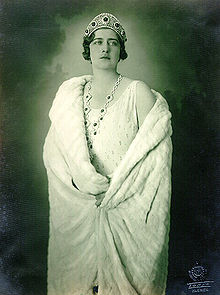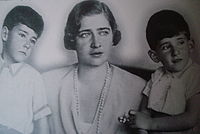- Maria of Yugoslavia
-
Maria of Yugoslavia
Марија од Југославије
Queen consort of Yugoslavia; prev. Queen consort of Serbs, Croats, and Slovenes Tenure 1922–1934 Spouse Alexander I of Yugoslavia Issue Peter II of Yugoslavia
Prince Tomislav
Prince AndrejHouse House of Karađorđević
House of Hohenzollern-SigmaringenFather Ferdinand I of Romania Mother Marie of Romania Born 6 January 1900
GothaDied 22 June 1961 (aged 61)
London, EnglandBurial Royal Burial Ground
Frogmore, WindsorReligion Eastern Orthodox Styles of
Queen Marija (as consort)Reference style Her Majesty Spoken style Your Majesty Alternative style Ma'am Maria of Yugoslavia (Serbian: Marija Karađorđević, Марија Карађорђевић; 6 January 1900 – 22 June 1961) was the Queen consort of King Alexander I of Yugoslavia. She was originally a princess of Romania.
Contents
Early life
She was born in Gotha, Thuringia, in Germany, during the reigns of her maternal grandfather Alfred, Duke of Saxe-Coburg and Gotha, and her grand-uncle King Carol I of Romania. She was known as Mignon in the family to distinguish her from her mother. Her mother was Queen Marie of Romania, a daughter of Prince Alfred, Duke of Edinburgh, a son of Queen Victoria of the United Kingdom. Her maternal great-grandfather was Emperor Alexander II of Russia. Maria's father was King Ferdinand I of Romania. Through her paternal side she was also a great-granddaughter of Maria II of Portugal.
During the World War I, she worked as a nurse with her mother.
Marriage and children
She married Alexander I of Yugoslavia, King of the Kingdom of Serbs, Croats and Slovenes in Belgrade on 8 June 1922, and had three sons:
- King Peter II (1923–1970)
- Prince Tomislav (1928–2000)
- Prince Andrej (1929–1990)
Following the assassination of King Alexander I of Yugoslavia in Marseille in 1934, her oldest son became Peter II of Yugoslavia, the last Yugoslav king. She was given the title Queen Mother of Yugoslavia in 1941. She moved to a farm in England and lived a relatively normal life, without royal extravagance. Maria was well educated. She spoke several languages fluently and enjoyed painting and sculpting. She also drove a car by herself,[citation needed] which was very unusual for royalty at the time.
She died in exile in London on 22 June 1961 and is interred at the Royal Burial Ground at Frogmore, which adjoins Windsor Castle.
Humanitarian work
Queen Maria was popular and respected, by the people of Yugoslavian public, and is still well thought of in the region. She was regarded as an ideal wife and mother according to the contemporary Serbian ideal and described as a humble person. She was engaged in several social projects. In the eyes of the Serbian people, she remain one of the greatest humanitarian patrons of the Balkan region.[citation needed]
Streets are named in her memory, such as “Ulica kraljice Marije” or “Queen Maria Street”, and numerous schools and other organizations still carry her name.
Ancestors
Sources
- This page is a translation of its Serbian equivalent.
External links
Succession
Maria of YugoslaviaCadet branch of the House of HohenzollernBorn: 6 January 1900 Died: 22 June 1961Yugoslavian royalty Vacant Title last held byDraga Obrenović
as Queen Consort of SerbiaQueen consort of Serbs, Croats, and Slovenes
Queen consort of Yugoslavia
8 June 1922–9 October 1934Vacant Title next held byAlexandra of Greece and DenmarkRomanian princesses by birth 1st Generation Princess Maria2nd Generation Elisabeta, Queen of the Hellenes · Maria, Queen of Yugoslavia · Ileana, Archduchess Anton of Austria-Tuscany3rd Generation none4th Generation Categories:- Romanian princesses
- Yugoslav queens consort
- House of Karađorđević
- House of Hohenzollern-Sigmaringen
- Romanian Orthodox Christians
- 1900 births
- 1961 deaths
- People from Gotha
Wikimedia Foundation. 2010.

